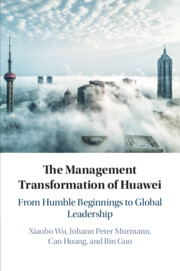Book contents
- The Management Transformation of Huawei
- The Management Transformation of Huawei
- Copyright page
- Contents
- Figures
- Tables
- Contributors
- Preface
- 1 The Management Transformation of Huawei
- 2 The Executive Management Team and Organizational Change
- 3 Transforming Product Development at Huawei
- 4 Huawei’s Transformation of Supply Chain Management
- 5 Financial Management Transformation in Huawei
- 6 The Transformation of Huawei’s HR System
- 7 Huawei’s Internationalization Journey
- 8 Huawei’s R&D Management Transformation
- 9 Huawei’s Intellectual Property Management Transformation
- 10 The Management Transformation of Huawei
- Book part
- Index
- References
8 - Huawei’s R&D Management Transformation
Published online by Cambridge University Press: 21 March 2020
- The Management Transformation of Huawei
- The Management Transformation of Huawei
- Copyright page
- Contents
- Figures
- Tables
- Contributors
- Preface
- 1 The Management Transformation of Huawei
- 2 The Executive Management Team and Organizational Change
- 3 Transforming Product Development at Huawei
- 4 Huawei’s Transformation of Supply Chain Management
- 5 Financial Management Transformation in Huawei
- 6 The Transformation of Huawei’s HR System
- 7 Huawei’s Internationalization Journey
- 8 Huawei’s R&D Management Transformation
- 9 Huawei’s Intellectual Property Management Transformation
- 10 The Management Transformation of Huawei
- Book part
- Index
- References
Summary
Although Huawei started its business as a small agent in 1987, the firm began the independent development of telecommunications equipment in its fouth year of operation and then gradually increased its R&D investments over the years. As the scale of R&D efforts increased, Huawei encountered significant problems with its organization of R&D and felt that it was necessary to transform how it conducts R&D several times over its thirty-year history. In this chapter, we develop a four-step model to analyze three major R&D management transformations in Huawei’s long history of R&D activities. The first transformation, from 1991 to 1995, helped Huawei to establish an informal R&D system; the second transformation, from 1995 to 1998, changed the informal R&D management system into a formal system with clear structures and processes; and finally, the third transformation built up a process-oriented, high-performing R&D organization. We find that although the transformations shifted Huawei’s focus from making structural changes to process changes, all of them were closely aligned with the firm’s market position and with its strategic re-orientation.
Keywords
- Type
- Chapter
- Information
- The Management Transformation of HuaweiFrom Humble Beginnings to Global Leadership, pp. 292 - 346Publisher: Cambridge University PressPrint publication year: 2020
References
- 1
- Cited by



